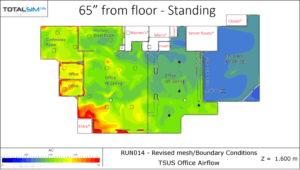The importance of proper airflow and ventilation was certainly brought to the world’s attention during the height of the pandemic, but its significance shouldn’t be dismissed now that the worst appears to be behind us. Back in 2021, when most of our team was still working from home, we decided to investigate the airflow within the TotalSim US office space. Because we’re engineers and CFD simulation experts, it got a bit complex, and you can read the full case study here.
We primarily leveraged portions of the OpenFOAMⓇ toolset to assess air changes per hour (ACPH or AC/hr) within the office space given certain real-world criteria that reflect how our staff works and moves on a daily basis.

What we discovered is that the TotalSim US office airflow is better than expected at protecting staff from aerosol contaminants. Referencing the CDC standard for Airborne Infection Isolation (in hospital units) that requires a minimum of 6 AC/hr (for older settings) or 12 AC/hr (for new build), TotalSim’s office ventilation stacked up pretty well. Our results showed the office space to have consistent ventilation near 8 AC/hr in the area where most of the staff is situated. While this is not at the ideal level of 12, it is better than we expected before conducting the simulation.
Prior to this study, we thought the private offices would have the worst ventilation when, in fact, they have the best, at over 10 AC/hr. This study really cemented what we already know to be true about CFD—it upends assumptions using concrete data and is the ideal way to visualize what’s actually happening in complex multiphysics situations involving fluid/air flow.
With return-to-office mandates taking hold across the country, businesses would benefit from understanding the airflow within their offices and how it can be improved to better prevent the spread of illness and resulting absenteeism. As more and more companies bring workers back to the office—not to mention schools, daycares and other congregate settings that contend with a variety of airborne viruses such as the flu and RSV—having a thorough understanding of airflow within a building and how it can be improved is a smart investment for operational efficiency. CFD simulation studies are a highly effective way to evaluate and optimize HVAC and other building systems for the benefit of all.
Related Content
The Strategic Advantage of Outsourcing in a Down Economy – Part 1
Want to keep up with the news from TotalSim? Why not subscribe to our e-Brief?
